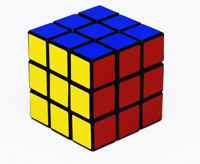Difference between revisions of "Cube"
From Nordan Symposia
Jump to navigationJump to search (Created page with 'File:lighterstill.jpg In geometry, a '''cube'''is a three-dimensional solid object bounded by six [http://en.wikipedia.org/wiki/Square_(geometry) square] faces, [[facets...') |
m (Text replacement - "http://" to "https://") |
||
| (One intermediate revision by one other user not shown) | |||
| Line 1: | Line 1: | ||
| − | [[File:lighterstill.jpg]] | + | [[File:lighterstill.jpg]][[File:Cube.jpg|right|frame]] |
| − | In geometry, a '''cube'''is a three-[[dimensional]] solid object bounded by six [ | + | In geometry, a '''cube'' 'is a three-[[dimensional]] solid object bounded by six [https://en.wikipedia.org/wiki/Square_(geometry) square] faces, [[facets]] or sides, with three meeting at each [https://en.wiktionary.org/wiki/vertex vertex]. The cube can also be called a regular [https://en.wikipedia.org/wiki/Hexahedron hexahedron] and is one of the five [https://en.wikipedia.org/wiki/Platonic_solid Platonic solids]. It is a special kind of square [https://en.wikipedia.org/wiki/Prism_(geometry) prism], of rectangular [https://en.wikipedia.org/wiki/Parallelepiped parallelepiped] and of [https://en.wikipedia.org/wiki/Trigonal_trapezohedron trigonal trapezohedron]. The cube is dual to the [https://en.wikipedia.org/wiki/Octahedron octahedron]. It has cubical [[symmetry]] (also called octahedral symmetry). |
A cube is the three-dimensional case of the more general concept of a hypercube. | A cube is the three-dimensional case of the more general concept of a hypercube. | ||
| Line 7: | Line 7: | ||
It has 11 nets. If one were to [[color]] the cube so that no two adjacent faces had the same colour, one would need 3 colours. | It has 11 nets. If one were to [[color]] the cube so that no two adjacent faces had the same colour, one would need 3 colours. | ||
| − | If the original cube has edge length 1, its dual [ | + | If the original cube has edge length 1, its dual [https://en.wikipedia.org/wiki/Octahedron octahedron] has edge length [[File:Square2.jpg]].[https://en.wikipedia.org/wiki/Cube] |
[[Category: Mathematics]] | [[Category: Mathematics]] | ||
Latest revision as of 23:41, 12 December 2020
In geometry, a 'cube 'is a three-dimensional solid object bounded by six square faces, facets or sides, with three meeting at each vertex. The cube can also be called a regular hexahedron and is one of the five Platonic solids. It is a special kind of square prism, of rectangular parallelepiped and of trigonal trapezohedron. The cube is dual to the octahedron. It has cubical symmetry (also called octahedral symmetry).
A cube is the three-dimensional case of the more general concept of a hypercube.
It has 11 nets. If one were to color the cube so that no two adjacent faces had the same colour, one would need 3 colours.
If the original cube has edge length 1, its dual octahedron has edge length ![]() .[1]
.[1]
